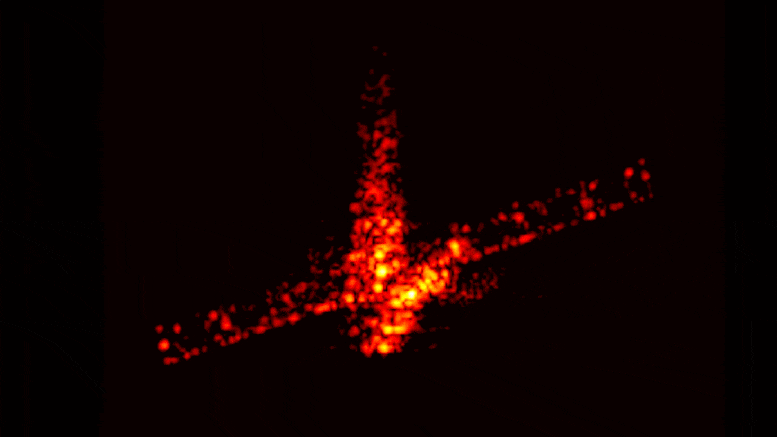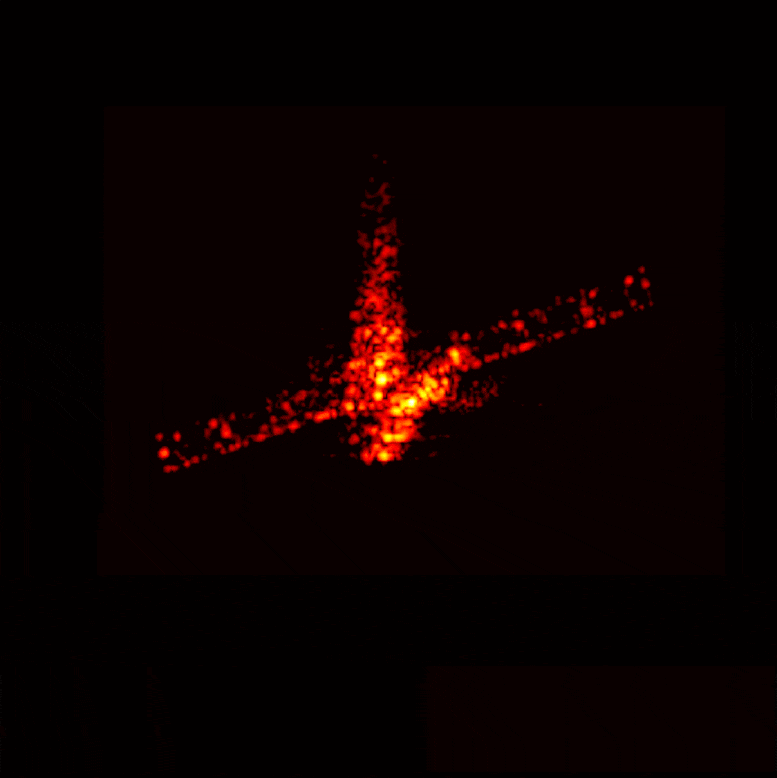

Final images of Aeolus during its brief phase as space debris acquired by the Space Observation Radar TIRA of Fraunhofer FHR. (Note the color represents the radar echo intensity, not temperature.) Credit: Fraunhofer FHR
Aeolus was in orbit around Earth for four years, eleven months, and six days. For three hours at the very end, a very brief period, it was space debris. This new animation is made from the last eight images ever taken of ESA’s wind-profiling mission, showing it beginning to tumble as it was buffeted by Earth’s atmosphere, during its very brief ‘junk’ phase.
International regulations on space debris mitigation set a limit on how long a satellite should linger in orbit once its mission is complete – it mustn’t be longer than 25 years.
For missions flying at low altitudes, their return is made faster as they are grasped by Earth’s wispy atmosphere and are quickly brought home.
During Aeolus’s first-of-its-kind assisted reentry in July, not only was the (already low) risk from falling debris reduced by a factor of 150, but the time during which Aeolus was left uncontrolled in orbit was shortened by a few weeks, limiting the risk of collision with other satellites in this vital space highway.

In this infographic from ESA and UNOOSA, find out how long it would take satellites at different altitudes to naturally fall back to Earth, and what must be done to responsibly dispose of them at the end of their lives. Credit: ESA / UNOOSA, CC BY-SA 3.0 IGO
Moving Moments
Aeolus became debris after the last command was executed at 17:43 CEST on July 28, 2023, after which the Flight Control Team could no longer speak to, hear from, or influence the satellite. After months of preparation and a week of intense and critical operations, the team had done everything they could, the satellite was passivated – turned off – and ‘handed over’ to ESA’s Space Debris Office which tracked its final descent.
Looking at the ground track (see the map below), the path on Earth that Aeolus was likely to fly over, it was clear that the Tracking and Imaging Radar (TIRA) at Fraunhofer FHR in Germany would get a good view. Using their 34-m antenna, TIRA tracked Aeolus at around 18:20 CEST for about four minutes.

Aeolus reentered over Antarctica on July 28, 2023, at 20:40-42 CEST. By turning Aeolus’s natural, uncontrolled reentry into an assisted one, and choosing the best reentry orbit, the already very small risk from any surviving fragments landing near populated areas was made a further 150 times less risky. Credit: ESA
Spacecraft Observations and Final Reentry
“Spacecraft operators are used to being in a dialogue with their missions, but debris can’t talk. These final observations confirmed that Aeolus’s final burn had gone well and that the now ‘dead’ satellite had gotten into the expected elliptical orbit, with a minimum altitude of 120km,” explains Benjamin Bastida Virgili, expert in ESA’s Space Debris Office.
“If you think of Aeolus’s path as a slightly squashed circle, rather than a line, that circle was getting smaller and more circular as it returned, but its altitude would still go up and down. We used this orbit information to compute a new estimate of Aeolus’s reentry time, which occurred just over two hours later and on our planned ground track.”
This was the last time the mission teams saw Aeolus. Still whole, it was just two hours from falling to pieces in Earth’s atmosphere over Antarctica, far from inhabited regions.
At around 20:40 CEST for about two minutes, Aeolus became a fireball – a temporary shooting star in the atmosphere.
“Normally, once a mission goes into the nose of its rocket and the fairing closes around it, that’s the last time we expect to ever see it,” says Aeolus Mission Manager Tommaso Parrinello.
“With Aeolus, in a remarkable example of sustainable spaceflight and responsible operations, we stayed with the mission for as long as we could, guiding its return as much as it was possible to do, and these images are our final farewell to the mission we all miss, but whose legacy lives on.”

